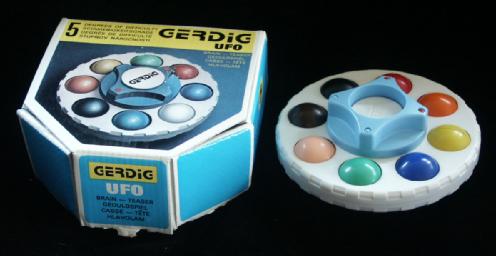


There are several puzzles called Ufo. Like most of these, this one also consists of a disc which is split into two layers which can rotate about the central axis. Spaced evenly around this disk are 8 spheres of different colours. These are split into an upper and a lower half, so that when the layers of the disc are turned, one half of each sphere travels with each layer. In the middle of the puzzle is a button that can be pushed up or down. In the simplest difficulty setting, moving the button will turn over one sphere. By turning the central hub before pressing its button, you can choose which sphere is turned over.
Inside the centre hub there is a clever rack and pinion mechanism that turns over a sphere when the button is moved. You can rearrange the pieces of this mechanism so that up to four spheres are turned over simultaneously by the button. This gives five difficulty settings. The spheres that turn over in each setting are:
| 1. | One sphere. | |
| 2. | Two opposite spheres. | |
| 3. | Four spheres. | |
| 4. | Two spheres at 90 degrees to each other. | |
| 5. | Three spheres. |
After setting the level, you can set little markers on the hub to show which sides are active.
The various difficulty settings will be treated separately below. The order listed here is that given in the leaflet of the puzzle. In my opinion this is not in increasing order of difficulty.
The Ufo was invented by Gerhard Huncaga, and has patent US 5,370,394 granted on 6 December 1994 and a German patent DE 4106896 granted on 5 March 1991.
If your browser supports JavaScript, then you can play Gerdig Ufo by clicking the link below:
Level 1. | One sphere. |
|---|
There are 16 pieces, 2 of each colour. They can therefore be arranged in
at most 16!/28=81,729,648,000 positions. All these positions
are indeed attainable. The orientation of the puzzle is immaterial,
so there are actually only about 16!/(28·16) = 5,108,103,000
distinct positions. Some positions are symmetrical under certain rotations
of the whole puzzle, so this number is a slight underestimate. The exact number
can be calculated using Burnside's Lemma, and
this gives 5,108,125,680 distinct positions. The colours in the solution are
equivalent however, so there are 8!/16 = 2,520 solutions.
If positions that differ only by recolouring are considered the same, then
there is only one solution, but the total number of positions is a bit more than
16!/(28·16·8!), again because some positions exhibit
symmetry. Applying Burnside's Lemma in this case is quite tricky, and if I have
calculated this correctly, there are actually 130,040 possible essentially
distinct positions.
Phase 1: Solve one sphere.
Phase 2: Solve the rest of the spheres.
Level 2. | Two opposite spheres. |
|---|
Pieces on opposite sides of the puzzle always remain so. Therefore such a pair
can be considered as if it were a single puzzle piece with two orientations.
There are then 8 pieces each with 2 orientations occurring in 4 identical pairs.
They can therefore be arranged in at most 8!·28/24
= 645,120 positions. All these positions are indeed attainable. The orientation
of the puzzle is immaterial, so there are actually only about
8!·28/(16·24) = 40,320 distinct positions.
Some positions are symmetrical under certain rotations of the whole puzzle, so
this number is a slight underestimate. The exact number can be calculated using
Burnside's Lemma, and this gives 40,332 distinct
positions. The colours in the solution are equivalent however, so there are
4!·24/16 = 24 solutions.
If positions that differ only by recolouring are considered the same then,
if I have applied Burnside's Lemma correctly, there are actually 262 essentially
distinct positions.
Level 3. | Four spheres. |
|---|
The 16 pieces actually split into 4 sets which each move as a unit. Such a set of 4 pieces can be considered as if they were a single puzzle piece with four orientations. There are then 4 pieces each with 4 orientations occurring in 2 identical pairs. They can therefore be arranged in at most 4!·44/2!2 = 1,536 positions. All these positions are indeed attainable. The orientation of the puzzle is immaterial, so there are actually only 4!·44/(8·2!2) = 192 distinct positions. This number is exact because none of the positions are symmetrical under rotations of the whole puzzle. The order of the colours in the solution does not matter, so there are 4 solutions.
Level 4. | Two spheres at 90 degrees to each other. |
|---|
This has the same number of positions as level 1, i.e. there are 5,108,125,680 distinct positions, or 130,040 if positions that differ only by recolouring are considered the same.
Phase 1: Separate the colours.
This phase puts four pairs of pieces in each disk, so that there are only
four colours in each layer.
Phase 2: Rearrangement.
This phase arranges the pieces from the top layer into one set of
4 spheres, and those of the bottom layer in the other set.
Phase 3: Solve the spheres.
Remember that the spheres fall into two sets of four, and you can solve these
independently from each other as the markers will always be on spheres from the
same set.
Level 5. | Three spheres. |
|---|
This has the same number of positions as level 1, i.e. there are 5,108,125,680 distinct positions, or 130,040 if positions that differ only by recolouring are considered the same.